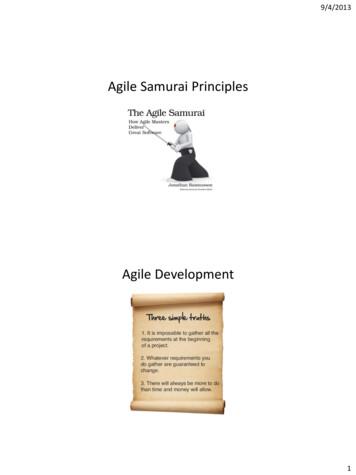Architecture Review In Agile Development
Architecture Review in AgileDevelopmentSofia ShermanIrit HadarEthan HadarJay HarrisonUniversity of HaifaCA TechnologiesSoftware Architecture Lab.
Agenda Problem statement Proposed solution Evidence from the fieldSoftware Architecture Lab.2
Historic One Phase Architecture Review ProcessSoftware Architecture Lab.3
Historic One Phase Architecture Review ProcessDevelopment Team PerspectiveSoftware Architecture Lab.4
Historic One Phase Architecture Review ProcessReview Team PerspectiveSoftware Architecture Lab.5
Agile Software Development Model The main characteristics of agile development: Flexibility Minimalism Collaboration Emphasizes rapid and flexible development Transforms the development process from beingprocess-centric to human-centric Favors operating software over documentationSoftware Architecture Lab.6
The Proposed Solution1. Architecture Abstract Specification (AAS) Document2. Two phase review processSoftware Architecture Lab.7
AAS: Brief ReminderAbstract Architecture Specification (AAS) An automatically generated short (4-6 pages)architecture document aligned with Agile’sexpectation for minimalism, flexibility and collaboration. Includes the most relevant and updated informationregarding the proposed architecture Kept short by employing elevator speech conceptsSoftware Architecture Lab.8
Two Phase Agile Architecture ReviewSoftware Architecture Lab.9
Two Phase Review Process– Phase 1Initial Peer Review (during planning sprint)Participants:2-3 Project team members& BU DE/Chief ArchitectPropose:1) To receive & incorporatepeer feedback2) Review for correctness &compliance to companystandardsAAS is a summary of the mainprinciples of proposed architecture.AAS is generated from the AAS toolParticipants:2-3 DE/Chief Architects from the DE council1 DE from the product’s BU1 or 2 DEs MUST be from another BUPropose:1) Provide sanity check & general correctness2) Provide multi-BU insightSoftware Architecture Lab.10
Two Phase Review Process– Phase 2Cross Business Unit Review (prior to end of Planning Sprint)Participants:All Members from the teamThe DE/Chief Architect of the BU4-5 DE’ from other Bus (NOTE: allDEs MAY participate)Propose:1) Ensure consistency in feedbackreceived by teams in different BUs2) Provide multi-BU insightParticipants:All Members from the teamThe DE/Chief Architect of the BUTechnical Community (invited)Propose:1) Information sharing of thedesign of critical components2) General education on designbest practices & expectationsSoftware Architecture Lab.11
Two-Phase Review Process in PracticeWe observed and analyzed review processes for 90 projects: 48 based on previous review process & documents, 42 based on two-phase review process & documentsSoftware Architecture Lab.12
Two-Phase Review Process in PracticeExperience and Result Shortened “start of project to architecture approved” “Versions” averaged 4.4 months versus 6.5,“Releases” 6 months versus 7.7 Reduced significant final review comments from an average of 7 to 3 The phase 1 review identified 15 projects where no phase 2 review was required Saving hundreds of staff hours of senior level participants over the course of a year Reduced the time required to conduct multi-BU reviews From 120 minute typical to less than 90 typical action than the TLDS Teams reported that the process was less stressful Even “enjoyable” because of ongoing interaction with senior members of the technicalcommunitySoftware Architecture Lab.13
Two-Phase Review Process in PracticeExperience and Result, cont Some extended team members felt they now lacked some information thatthey received in the previous format Technical Publications, Field SupportAAS contains less “tutorial and background” information than the TLDS.Software Architecture Lab.14
Two Phase Review Process: The benefits Ongoing “mentoring” as part of architecture reviewprocess Collaborative and constructive review Project team (internal) review as a formal part ofarchitecture review process Ongoing DE engagement simplifies and facilitates thecommunication among architects and reviewersSoftware Architecture Lab.15
Questions?Thank YouSoftware Architecture Lab.16
Initial Peer Review (during planning sprint) AAS is a summary of the main principles of proposed architecture. AAS is generated from the AAS tool Participants: 2-3 DE/Chief Architects from the DE council 1 DE from the product’s BU 1 or 2 DEs MUST be from another BU P
1. The need for an agile way of working 6 2. The need for an agile way of working 9 3. Agile Core Values - Agile Project Management Vs. 10 Agile Event Management 4. Agile principles 12 _Agile Principles of Agile Project Management 13 _Agile Principles of VOK DAMS Agile Event Management 14 5. Agile Methods 16 _Scrum in Short 16 _Kanban in Short 18
Agile Estimating and Planning by Mike Cohn Agile Game Development with Scrum by Clinton Keith Agile Product Ownership by Roman Pichler Agile Project Management with Scrum by Ken Schwaber Agile Retrospectives by Esther Derby and Diana Larsen Agile Testing: A Practical Guide for Testers and Agile Teams by Lisa Crispin and .
The most popular agile methodologies include: extreme programming (XP), Scrum, Crystal, Dynamic Sys-tems Development (DSDM), Lean Development, and Feature Driven Development (FDD). All Agile methods share a common vision and core values of the Agile Manifesto. Agile Methods: Some well-known agile software development methods include: Agile .
1.1 Purpose of the Agile Extension to the BABOK Guide1 1.2 What is Agile Business Analysis?2 1.3 Structure6 Chapter 2:The Agile Mindset 2.1 What is an Agile Mindset?7 2.2 The Agile Mindset, Methodologies, and Frameworks8 2.3 Applying the Agile Mindset9 2.4 Agile Extension and the Agile Ma
Agile World View "Agility" has manydimensions other than IT It ranges from leadership to technological agility Today's focus is on organizational & enterprise agility Agile Leaders Agile Organization Change Agile Acquisition & Contracting Agile Strategic Planning Agile Capability Analysis Agile Program Management Agile Tech.
1. Agile methods are undisciplined and not measurable. 2. Agile methods have no project management. 3. Agile methods apply only to software development. 4. Agile methods have no documentation. 5. Agile methods have no requirements. 6. Agile methods only work with small colocated teams.-7. Agile methods do not include planning. 8.
The Agile Customer . 9/6/2012 6 Agile Development Team Agile Analyst . 9/6/2012 7 Agile Programmer Agile Tester . 9/6/2012 8 Agile Manager Agile Usability Designer . 9/6/2012 9 Kicking off a project The Inception Deck –Ten questions you’d be crazy not to ask before starting any
The Agile Customer. 9/4/2013 6 Agile Development Team Agile Analyst. 9/4/2013 7 Agile Programmer Agile Tester. 9/4/2013 8 Agile Manager Agile Usability Designer. 9/4/2013 9 Kicking off a project The Inception Deck –Ten questions you’d be crazy not to ask before starting any software






















